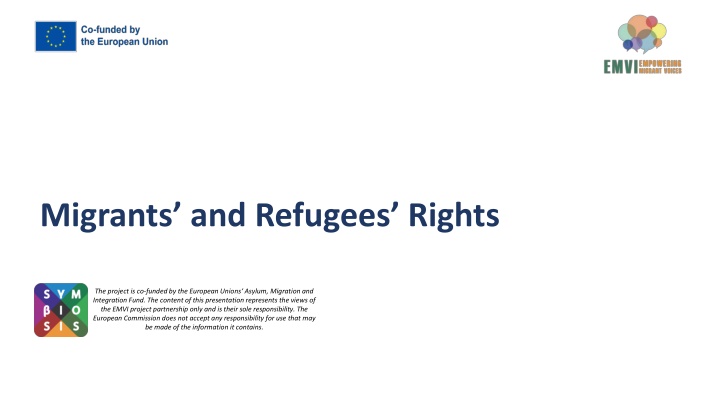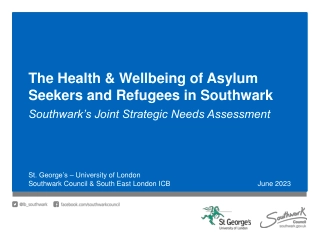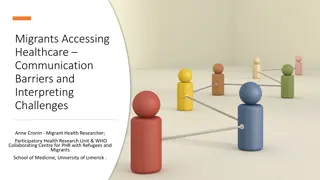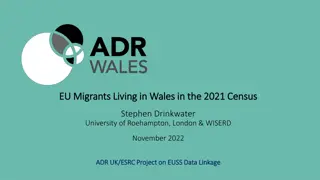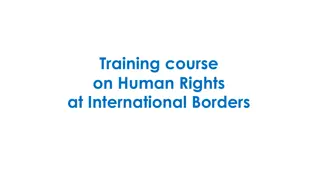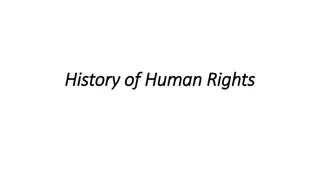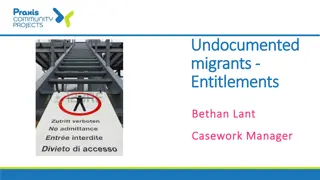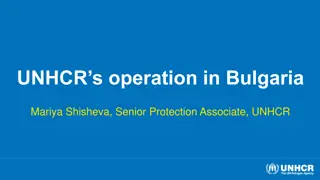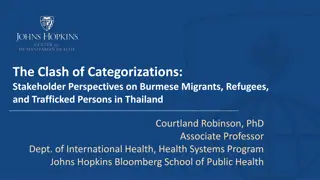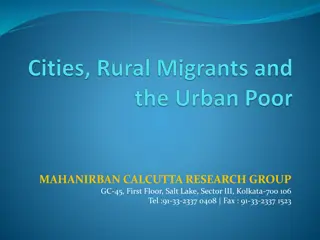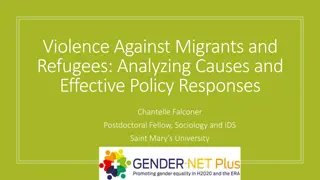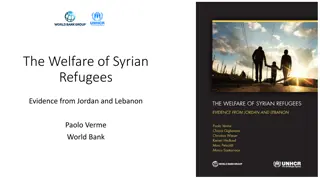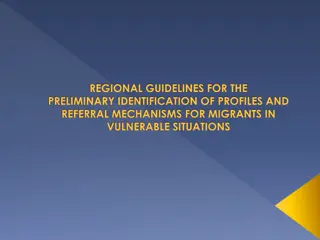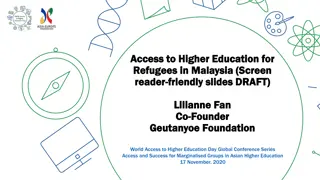Migrants’ and Refugees’ Rights
The project focuses on the rights of migrants and refugees, exploring definitions, the importance of rights in migration, humanitarian responses, and challenges faced in the current context. It delves into the distinctions between refugees, migrants, displaced persons, and asylum seekers, shedding light on the vulnerabilities in large migration movements.
Download Presentation

Please find below an Image/Link to download the presentation.
The content on the website is provided AS IS for your information and personal use only. It may not be sold, licensed, or shared on other websites without obtaining consent from the author.If you encounter any issues during the download, it is possible that the publisher has removed the file from their server.
You are allowed to download the files provided on this website for personal or commercial use, subject to the condition that they are used lawfully. All files are the property of their respective owners.
The content on the website is provided AS IS for your information and personal use only. It may not be sold, licensed, or shared on other websites without obtaining consent from the author.
E N D
Presentation Transcript
Migrants and Refugees Rights The project is co-funded by the European Unions Asylum, Migration and Integration Fund. The content of this presentation represents the views of the EMVI project partnership only and is their sole responsibility. The European Commission does not accept any responsibility for use that may be made of the information it contains.
In this presentation: Definitions Why rights matter in migration, displacement and exile? Humanitarian response and questions of rights Move from refugee rights to protection Withering the issues of rights in the context of privatization of asylum and criminalization of humanitarian assistance
Refugee, Migrant, Displaced Person, Asylum Seeker? Refugee: Forced to flee a country due to persecution Internally displaced: Forced to flee but does not cross a border to leave their country Asylum seeker: A refugee who is seeking protection, but no country has determined whether or not the person meets the definition of a refugee Migrant : A person who moves, usually voluntarily, to live or work, either temporarily or permanently. May or may not cross a border.
MIGRANT? Voluntary? Forced? Smuggled migrant Stateless person Refugee Irregular migrant Separated child Unaccompanied child Asylum seeker Migrant worker 4
Who is a migrant? In the absence of a universal, legal definition of an international migrant: Any person who is outside a State of which he or she is a citizen or national (temporarily or permanently, regularly or irregularly) OHCHR Recommended Principles and Guidelines on Human Rights at International Borders, 2014
Vulnerabilities in large (mixed) movements Within the context of many migration movements, a diverse group of people move together, and often share the same risks of human rights violations. Many people on the move today fall outside established legal categories (or fall in and out of categories), but are nonetheless in need of specific protection interventions. People compelled to move in large-scale, irregular and precarious movements are particularly at risk of harm.
Migrants in vulnerable situations Migrants can be at risk of human rights violations due to the conditions they face in countries of origin, which compel them to move, and to which they may not be returned.
Why do people move? Livelihood economic opportunity Food, water insecurity Discrimi- nation, stigma, prejudice Poverty War Conflict Climate Change, Natural disasters Persecution To access healthcare, education Violence, exploitatio n Family reunification
Migrants in vulnerable situations (contd) Migrants can be at risk of human rights violations as a result of circumstances that they face en route. Structural contexts are diverse, and inherent vulnerabilities can lead to intersectional risk (e.g. children). Journeys are long, dangerous and often multi-directional. Some may never reach their intended destination Risks faced at destination.
International Legal Protection Framework includes Refugee Law Law of the Seas UNTOC + Protocols Statelessness Conventions International Humanitarian Law Internatio nal labour law International Human Rights Law Without discrimination
Core International Human Rights Instruments International Covenant on Civil and Political Rights (1966) ICCPR ICESCR International Covenant on Economic, Social and Cultural Rights (1966) ICESCR The Convention on the Elimination of All Forms of Racial Discrimination (1965) CERD Convention on the Elimination of All Forms of Discrimination against Women (1979) CEDAW Convention against Torture and Other Cruel, Inhuman or Degrading Treatment or Punishment (1984) CAT Convention on the Rights of the Child (1989) CRC International Convention on the Protection of the Rights of All Migrant Workers and Members of Their Families (1990) ICRMW CRPD Convention on the Rights of Persons with Disabilities (2006) CRPD CED Convention on the Protection of all Persons from Enforced Disappearance (2006) CED
Universal Declaration of Human Rights (1948) Recognition of the inherent dignity and of the equal and inalienable rights of all members of the human family (Preamble) All All human beings are born free and equal in dignity and rights (Article 1) human beings Everyone is entitled to all the rights and freedoms set forth in this Declaration, without distinction of any kind (Article 2) Everyone
The case for principles and practical guidance An international legal framework exists that specifically protects the rights of all migrants. However, more precise understanding of the human rights standards for migrants (in large movements), as well as of how States (and other stakeholders) can operationalize these standards in practice, is lacking. Need for particular understanding of the protection gaps experienced by migrants who will not benefit from refugee protection, but nonetheless are not moving voluntarily and/or in a protected manner. (e.g. climate-change induced migration)
Why rights matter in migration, displacement, humanitarian response and exile? Much of the debates centered around needs-based approaches to humanitarian assistance: Refugees and displaced persons viewed as recipients of charity and welfare Refugees viewed as problems and victims Focus on durable solutions Need to go beyond the physical needs of people encountering forced displacement Debates since the 1980s Need to strengthen institutions which are supposed to protect and promote a wide range of rights to livelihood to survival to autonomy to wellbeing To social protection and labour rights
The central claim: Migrant/Refugee The central claim: Migrant/Refugee- -centered and rights rights- -centered humanitarian response centered humanitarian response centered and 1949 Geneva Conventions, protocols and commentaries - the international humanitarian law (https://ihl-databases.icrc.org/applic/ihl/ihl.nsf/vwTreaties1949.xsp) The Refugee Convention of 1951 and 1954 Convention on Statelessness; The debates in the 1980s The main claims of Imposing Aid and the refugee focused response: Humanitarian aid as top-down and as charity Power and giving
Integration/Protection Integration/Protection based on needs and in the context of power relations Balanced reciprocity only possible between those with equal status In the context of integration, whether or not they are aware of it, state and non state stakeholders stand in an asymmetrical relationship to migrants and refugees who are symbolically disempowered through becoming clients of those upon whom they are dependent for the means of survival and security
Accountability, humanitarian assistance and rights Humanitarians - who control the distribution of aid - view themselves as accountable to the donors rather than to the beneficiaries Giving assistance is generally regarded as charity Humanitarians assume the power to decide who is deserving Power trap: inclusion or exclusion based on personal views those who express needs privileged rather than those who express their needs based on rights
Importance and key questions in rights-based approaches to humanitarian assistance Importance: Rights-based approaches recognize the agency of displaced persons Focus on their rights as human beings and protection based on rights rather than needs Key questions for rights-based humanitarian assistance in the international system: Who determines rights? Who guarantees them? Who is entitled to rights? Who bears the responsibility and accountability in implementing and providing rights?
Interactive discussion on who is Interactive discussion on who is deserving of refugee status/permanent deserving of refugee status/permanent residence/benefits/residence permit/ residence/benefits/residence permit/ Please recall your own experiences and present your arguments as to who decides and how on one of the above?
What has changed? Focus on rights-based approaches to assistance and protection (2000s) Localisation of aid and the recognising/seeing refugees as agents of their own faith Participatory approaches and rights
Human rights perspective in global migration and refugee governance Migration including forced displacement is specifically highlighted in Sustainable Development Goals (& the whole 2030 Agenda for Sustainable Development ) And is also necessarily implied / covered / &c. by many of the Goals The 2030 Agenda makes clear, inter alia, that we will facilitate orderly, safe, regular and responsible migration and mobility of people, including through the implementation of planned and well- managed migration policies (NY Declaration, para. 16) 21
New York Declaration for Refugees and Migrants 9/2016 https://www.youtube.com/watch?v=r2plN4VgUPI (2 mins) http://refugeesmigrants.un.org/new-york-declaration-refugees-and- migrants-0 A 24 page UN General Assembly resolution Adopted by 193 states At a UN Summit of heads of state/government In response to exceptional large movements , but aware that some points apply also for regular migration (#21) 22
From rights to protection 2021 70 years of UNHCR Refugee Convention to protect refugees Global Compact on Refugees 2018: Key principles : Solidarity in responding to refugees and displaced Equitable sharing and commitment to protecting refugees from danger and prosecution 80 % of people hosted by developing Key aims : Easy pressure on host countries Enhance refugee access to self-reliance Expand access to 3rd durable solutions Support safe conditions to reach resettlement destinations
European Union policies on Migration European Union policies on Migration http://jmonnet.symbiosis.org.gr/en/notebooks http://jmonnet.symbiosis.org.gr/en/notebooks- - educational educational- -tools/ tools/ Interactive exercise: Interactive exercise: Please discuss how EU policies are implemented in Please discuss how EU policies are implemented in your national context your national context
Challenges of Rights-based Approaches (RBA) Severe strains on host countries/ populations; limited aid budgets/ resources Implementing rights-based approaches more costly Continual resistance to rights: Changing asylum policies in Europe Withering away access to asylum Rights in theory; needs in practice Problems of responsibility/ accountability Universalism v/s particularism
Withering the rights The EU s adoption of the Facilitator s Package - EU s legislative action to tackle migrant smuggling into the EU: humanitarian actors have been charged are grounded in the EU Facilitator s Package The Facilitator s Package: the EU Council Directive 2002/90/EC of 28 November 2002, defining facilitation of unauthorized entry, transit and residence (the Facilitation Directive) the Council Framework Decision 2002/946/JHA28, on the strengthening of the penal framework to prevent the facilitation of unauthorized entry, transit and residence in the EU. The EU Council Directive defines the facilitation of unauthorized entry, transit and residence as: (i) intentionally assisting a non-EU national to enter or transit through the territory of an EU country, in breach of laws (ii) intentionally assisting a non-EU national to reside in the territory of an EU country, for financial gain (iii) instigating, assisting in or attempting to commit the above acts.
Withering the rights (cont) Article 1(2) of the Facilitation Directive contains an optional clause for Member States to explicitly exclude humanitarian actors from criminal sanctions. - a discretionary decision to be taken by individual EU Member States as to whether or not to exclude humanitarian acts from criminalization under the Facilitation Package, giving a wide margin of appreciation to the member states as to whether to criminalize actions that have a not-for-profit intent and whether to exclude humanitarian assistance from criminalization (ReSOMA, 2018).
Withering the rights (cont) Facilitating irregular entry is punished in all 28 EU Member States Allsopp (2017) - in placing special emphasis on imposing criminal sanctions for facilitators of stay who act for financial gain, the Facilitation Directive puts at greater risk of prosecution and conviction service providers to irregular migrants and other members of society, such as landlords.
Why rights still matter? Denial of human rights and lack of justice beyond refugees Refugees live the consequences of denial of rights, and the consequences of the shrinking rights enshrined in asylum procedures International protection feels often disempowering Subject to laws that were created for refugees but not by refugees Protect against us rather then protect us Right to asylum recognized under the international law as a right, but in practice refugees and asylum seekers in many pats of the world treated as criminals Move from as people at risk to as people as risk Even if right to asylum is granted, right to employment or education is often denied
Why rights still or even more matter? Categories, labels and the right to have rights Disconnection between top-down vision of rights, those who impose policies and those whom these policies affect Long term consequences of loosing human lives and human potential: Spending 10-20-30 years in camps (only 1% of refugees get resettled; 3% of refugees complete education) Life in waiting The key problem of rights locus of responsibility and accountability shifting and withering away
Some sources for further reading: Some sources for further reading: Agamben, Giorgio. We Refugees. Symposium, vol. 49, no. 2, 1995, pp. 114 19. Arendt, Hannah. We Refugees. Altogether Elsewhere: Writers on Exile., edited by Mark Robinson, Faber and Faber, 1994, pp. 110 19. Barnett, Laura. Global Governance and the Evolution of the International Refugee Regime. International Journal of Refugee Law, vol. 14, no. 2 3, 2002, pp. 238 62. Behrman, Simon. Law and Asylum: Space, Subject, Resistance. Routledge, 2018. Betts, Alexander. The Refugee Regime Complex. Refugee Survey Quarterly, vol. 29, no. 1, 2010. Crostello, Cathryn. The Human Rights of Migrants and Refugees in European Law. Oxford University Press, 2015. Goodwin-Gil, Guy S., and Jane McAdam. The Refugee in International Law. Oxford University Press, 2007. Hamlin, Rebecca. Let Me Be a Refugee: Administrative Justice and the Politics of Asylum in the United States, Canada, and Australia. Oxford University Press, 2014. Lippert, Randy. Governing Refugees: The Relevance of Governmentality to Understanding the International Refugee Regime. Alternatives: Global, Local, Political, vol. 24, 1999, pp. 295 328. Liu, Robyn. The International Government of Refugees. Global Governmentality: Governing International Spaces, edited by Wendy Larner and William Walters, Routledge, 2004, pp. 116 35. Malkki, Lisa. Refugees and Exile: From Refugee Studies to the National Order of Things. Annual Review of Anthropology, vol. 24, 1995, pp. 495 523. Salomon, Kim. Refugees in the Cold War: Towards a New International Refugee Regime in the Early Postwar Era. Lund University Press, 1991. Sautman, B. The Meaning of Well-Founded Fear of Persecution in United States Asylum Law and in International Law. Fordham International Law Journal, vol. 9, no. 3, 1985, pp. 483 539. Scalettaris, Guilia. Refugee Studies and the International Refugee Regime: A Reflection on a Desirable Separation. Refugee Survey Quarterly, vol. 26, no. 3, 2007.
